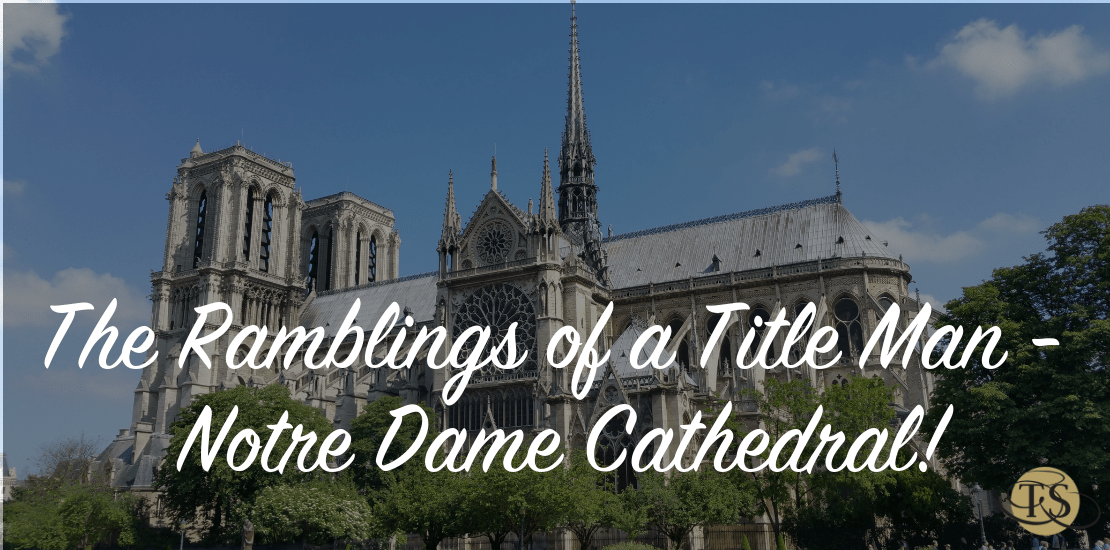On April 15, 2019, the world watched as images were streamed across the globe of the fire that destroyed the Notre Dame Cathedral in Paris, France. Over 400 first responders worked to save the 850-year-old structure and its valuable contents. A “bucket brigade” was set up to ferry artifacts from the vaults to safety. In the end, the fire that burned for 15 hours destroyed the roof, wooden pews and the spire above the roof. The facade of the building, the flying buttresses, and the bell towers were saved. The cause of the fire is suspected to be the restoration work that was ongoing.
A curious comment during one of the news shows got me wondering – who owns Notre Dame Cathedral? The answer has a history that is as complicated as the history of France. The news program I was watching stated that the Nation of France, not the Catholic Church, owned the famous Paris cathedral. That was puzzling to me so I went on a quest to find the title history of Notre Dame Cathedral.
Many churches have stood on that site prior to the construction of the current cathedral. The first structure, believed to be built during the Roman Empire, was converted from a pagan temple to a Roman temple to Jupiter to a Christian use. The early churches on the site included the 4th-century basilica of Saint-Étienne. Land used for churches in France and many countries enjoyed de facto ownership by the church and were controlled by the bishop or archbishop at the time. Churches often included many acres or hectares around them that were used for the production of food and leased to vassals or serfs. During Medieval times, lands were held by nobility in France and protected by a series of laws known as Primogeniture and entails. We would describe an “entail” in American terms as a series of remaindermen designed to keep land in one family ownership for centuries. Primogeniture is the right of inheritance by the eldest son, to the exclusion of any other children. Usually, the title of nobility also passed in this way.
The French Revolution changed the way land was owned and inherited in France in a profound way. The National Assembly began enacting laws that abolished Primogeniture and entails. In 1792, the Assembly took measures to abolish existing entails and ended the rights of those who were to or expected to inherit. Rights of all children to inherit an equal share were pushed forward. The land question was also pressed to the church in France at the time. Vast holdings of church land were confiscated and distributed to the land tenants that lived and worked on the land. Some estimates suggest that as many as 600,000 peasants became landowners under this transfer of land in the late 18th century.
During the French Revolution, the Cathedral’s name was changed to the Cult of Reason or the Cult of the Supreme Being. The building was looted, used for food storage at one time, and the statues were beheaded. The Statute of the Virgin Mary was replaced with a Statue of Liberty for a time. The ownership of the title in the late 18th century was clouded at best.
In 1801, a clear statement of the ownership of the title to the Cathedral was enacted. Napoleon Bonaparte signed the Concordat of 1801 with Pope Pious VII restoring the Catholic Church ownership of all churches in France (but not the non-worship land holdings that were sold off to land tenants). The agreement also restored the Catholic faith as the official religion of France. It also provided for financial support to the Catholic Church as compensation for the confiscation of land during the Revolution.
In 1905, a series of laws in France was enacted, including The French Law on the Separation of Churches and The State. This law did three things; first, it ended the payment of support that was enacted by Napoleon Bonaparte. Second, it eliminated the Catholic Church as the official religion of France. And third and most importantly, it confiscated the 70 Catholic churches in Paris to the State of France. The Vatican broke ties with the French government and remained at odds through the First World War. In the 1920s, both sides managed to reconcile their differences and some parts of the 1905 law were modified to be less objectionable to the Catholic Church. The status of the ownership of the Notre Dame Cathedral remains today as created by the law in 1905. Owned by the State of France, but with the Catholic Church as the beneficiary to use the structure for religious purposes in perpetuity. Call it a “forever leasehold.”
The rebuilding of the Cathedral is being supported by billions of Euros in donations. The Catholic Church has set up a fund to collect monies for the restoration and rebuilding of the Cathedral. Over 12 million visitors visit Notre Dame Cathedral in Paris each year. After the restoration is complete, the State of France will go on owning it, and the Catholic Church will proceed as the beneficiary for the foreseeable future.
“The greatest products of architecture are less the works of individuals than of society; rather the offspring of a nation’s effort, than the inspired flash of a man of genius…”
Victor Hugo, 1802 – 1885, French author and poet, The Hunchback of Notre-Dame, 1831
Sources:
Wikipedia “Notre-Dame de Paris” Accessed 4/28/2019
“Land Laws of France” Victoria University of Wellington 2016
Originally published by Michael Holden
DISCLAIMER: The opinions expressed herein are those of the author, Michael Holden, and do not represent any company or organization. While the information presented is believed to be accurate, it should not be a substitute for legal advice, and readers are strongly encouraged to seek independent legal counsel.


